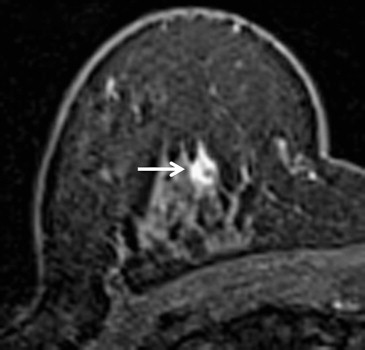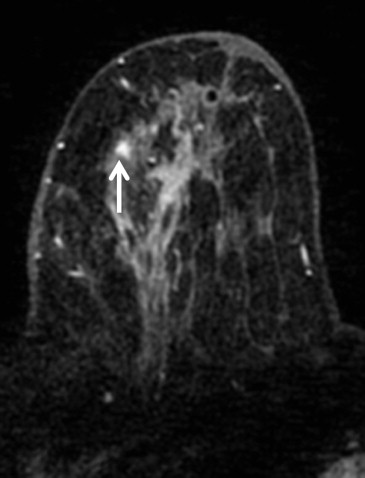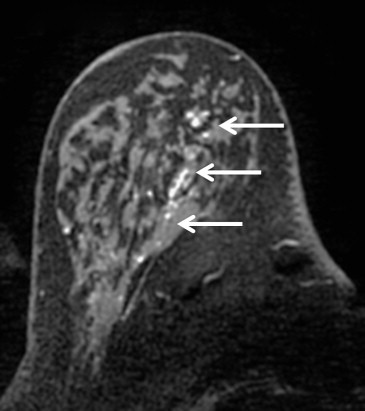Rationale and Objectives
To determine the cancelation rate of magnetic resonance imaging (MRI)-guided procedures in suspicious breast lesions initially detected at 3.0 Tesla (T) MRI.
Materials and Methods
With institutional review board approval, a Health Insurance Portability and Accountability Act–compliant retrospective review of 117 suspicious 3.0 T MRI-detected lesions in 101 patients scheduled to undergo MRI-guided procedures was performed; informed consent was waived. Patient information, imaging features, and outcome data were collected and compared among completed and canceled procedures using Fisher’s exact test.
Results
MRI-guided breast biopsies were canceled in 13% (15/117) because of lesion nonvisualization, including three (20%) masses, one (1%) focus, and 11 (73%) areas of nonmasslike enhancement. Median lesion size was 1.1 cm. Sixty percent (9/15) of nonvisualized lesions were associated with minimal or mild background parenchymal enhancement at MRI. The nonvisualization rate was not associated with patient age, menopausal status, lesion type, size, breast density, or background parenchymal enhancement ( P > .7 for each). No cancers were detected at original lesion sites in 14 (93%) patients undergoing follow-up imaging ( n = 11) or mastectomy ( n = 3) for cancer elsewhere; one (7%) was lost to follow-up.
Conclusion
The MRI-guided breast biopsy cancelation rate from nonvisualization of suspicious lesions originally detected with 3.0 T MRI scanning was 13%, similar to rates reported for lesions detected at 1.0 and 1.5 T MRI. No cancers were detected on follow-up imaging. Canceling MRI-guided biopsies because of lesion nonvisualization is a reasonable approach if measures are taken to ensure lesion resolution at the time of biopsy and at imaging follow-up.
Contrast-enhanced breast magnetic resonance imaging (MRI) is the most sensitive imaging modality for the detection of breast cancer. Because its superior sensitivity results from high-contrast resolution, suspicious lesions detected by MRI may not be visualized with other imaging modalities such as mammography and ultrasound . Histological sampling of suspicious, MRI-only-detected lesions must be performed using MRI-guided procedures such as MRI-guided vacuum-assisted core needle biopsy (VAB) and MRI-guided needle localization (NL). However, nonvisualization of a previously identified suspicious MRI-detected lesion in the breast on the day of MRI-guided intervention has been reported to occur between 5% and 15% of the time , resulting in procedure cancelation; most of these reports described diagnostic MRI exams performed on lower field strength 1.0 and 1.5 Tesla (T) MRI scanners .
Over the past 5–10 years, higher field strength 3.0 T MRI scanners have been used for cranial, musculoskeletal, and angiographic applications, showing promise for improving spatial resolution, contrast-to-noise ratios, and faster acquisition times . However, there is a paucity of data describing the use of higher field strength MRI for detection of breast lesions and subsequent procedure cancelation because of lesion nonvisualization during MRI-guided breast procedures. A recent study by Brennan et al describing cancelation of MRI-guided breast biopsy because of lesion nonvisualization included diagnostic MRI examinations performed using both 1.5- and 3.0-T scanners, but data pertaining to each magnetic field strength were not reported.
Get Radiology Tree app to read full this article<
Materials and methods
Study Population
Get Radiology Tree app to read full this article<
MRI Scanning Protocol
Get Radiology Tree app to read full this article<
Siemens Trio
Get Radiology Tree app to read full this article<
GE Signa
Get Radiology Tree app to read full this article<
MRI-guided Procedure Protocol
Get Radiology Tree app to read full this article<
Get Radiology Tree app to read full this article<
Canceled MRI-guided Procedures
Get Radiology Tree app to read full this article<
Get Radiology Tree app to read full this article<
Results
Get Radiology Tree app to read full this article<
Get Radiology Tree app to read full this article<
Patients Characteristics
Get Radiology Tree app to read full this article<
Table 1
Patient and Imaging Characteristics
Characteristic Canceled Biopsies ( n = 15, Lesions Not Visualized, %) Successful Biopsies ( n = 98, Lesions Visualized, %) ∗ P Value Patient age .6 ≤49 years 8 (53) 40/86 (47) ≥50 years 7 (47) 46/86 (53) Median 42 51 Range 28–81 30–78 Menopausal status .6 Pre 7/15 (47) 43/84 (51) Post 8/15 (53) 34/84 (40) Unknown N/A 7/84 (8) Indication for breast MRI Screening 6/15 (40) 37/84 (44) Diagnostic 9/15 (60) 47/84 (56) Breast density 1.0 Extremely or heterogeneous 9/15 (60) 56/84 (61) Scattered or fatty 4/15 (27) 30/84 (30) No mammogram available 22/15 (13) 12/84 (10) Background enhancement .8 Minimal or mild 9/15 (60) 56/84 (67) Moderate of marked 6/15 (40) 28/84 (33) Lesion size .4 ≤10 mm 6/15 (40) 29/98 (30) >10 mm 9/15 (60) 69/98 (70) Median 11 19 Range 5–84 3–114 Lesion type 1.0 Mass 3/15 (20) 20/98 (20) NMLE 11/15 (73) 71/98 (72) Focus 1/15 (7) 7/98 (7)
MRI, magnetic resonance imaging; NMLE, nonmasslike enhancement.
Get Radiology Tree app to read full this article<
Get Radiology Tree app to read full this article<
Imaging Characteristics
Get Radiology Tree app to read full this article<
Table 2
Morphologic Descriptors of Masses ( n = 23)
Descriptor Number of Masses Visualized ( n = 20) Number of Masses Nonvisualized ( n = 3) Shape Round 8/23 (35) 0/23 (0) Oval 4/23 (17) 1/23 (1) Lobular 1/23 (1) 0/23 (0) Irregular 7/23 (30) 2/23 (9) Margins Smooth 5/23 (22) 0/23 (0) Irregular 12/23 (52) 3/23 (13) Spiculated 3/23 (13) 0/23 (0) All masses 20/23 (87) 3/23 (13)
Data in parentheses are percentages.
Table 3
Morphologic Descriptors of NMLE ( n = 86)
Descriptor Number of NMLE Visualized ( n = 75) Number of NMLE Nonvisualized ( n = 11) Focal 25/86 (29) 4/86 (5) Linear/ductal 30/86 (35) 5/86 (6) Segmental 7/86 (8) 1/86 (1) Regional 11/86 (13) 1/86 (1) Diffuse 2/86 (2) 0/86 (0) All NMLE 75/86 (9) 11/86 (13)
NMLE, nonmasslike enhancement.
Data in parentheses are percentages.
Get Radiology Tree app to read full this article<
Get Radiology Tree app to read full this article<
Imaging and Histologic Follow-up
Get Radiology Tree app to read full this article<
Get Radiology Tree app to read full this article<
Discussion
Get Radiology Tree app to read full this article<
Get Radiology Tree app to read full this article<
Get Radiology Tree app to read full this article<
Get Radiology Tree app to read full this article<
Get Radiology Tree app to read full this article<
References
1. Berg W.A., Gutierrez L., NessAiver M.S., et. al.: Diagnostic accuracy of mammography, clinical examination, US, and MR imaging in preoperative assessment of breast cancer. Radiology 2004; 233: pp. 830-849.
2. Morris E.A., Liberman L., Dershaw D.D., et. al.: Preoperative MR imaging-guided needle localization of breast lesions. AJR Am J Roentgenol 2002; 178: pp. 1211-1220.
3. Hefler L., Casselman J., Amaya B., et. al.: Follow-up of breast lesions detected by MRI not biopsied due to absent enhancement of contrast medium. Eur Radiol 2003; 13: pp. 344-346.
4. Liberman L., Morris E.A., Dershaw D.D., et. al.: MR imaging of the ipsilateral breast in women with percutaneously proven breast cancer. AJR Am J Roentgenol 2003; 180: pp. 901-910.
5. Liberman L., Bracero N., Morris E., et. al.: MRI-guided 9-gauge vacuum-assisted breast biopsy: initial clinical experience. AJR Am J Roentgenol 2005; 185: pp. 183-193.
6. Hauth E.A., Jaeger H.J., Lubnau J., et. al.: MR-guided vacuum assisted breast biopsy with a handheld biopsy system: clinical experience and results in postinterventional MR mammography after 24 h. Eur Radiol 2008; 18: pp. 168-176.
7. Han B.K., Schnall M.D., Orel S.G., et. al.: Outcome of MRI-guided breast biopsy. AJR Am J Roentgenol 2008; 191: pp. 1798-1804.
8. Brennan S.B., Sung J.S., Dershaw D.D., et. al.: Cancellation of MR Imaging-guided breast biopsy due to lesion nonvisualization: frequency and follow-up. Radiology 2011; 261: pp. 92-99.
9. Saupe N., Prussmann K.P., Leuchinger R., et. al.: MR imaging of the wrist: comparison between 1.5- and 3-T MR imaging-preliminary experience. Radiology 2005; 234: pp. 256-264.
10. Phan C.M., Matsuura M., Bauer J.S., et. al.: Trabecular bone structure of the calcaneus: comparison of MR imaging at 3.0 and 1.5 T with micro-CT as the standard of reference. Radiology 2006; 239: pp. 488-496.
11. Heesakkers R.A.M., Futterer J.J., Hovels A.M., et. al.: Prostate cancer evaluated with ferumostran-10-enhanced T2*-weighted MR imaging at 1.5 and 3.0 T: early experience. Radiology 2006; 239: pp. 481-487.
12. Kijowski R., Blankenbaker D.G., Davis Kw, et. al.: Comparison of 1.5- and 3.0-T MR imaging for evaluating the articular cartilage of the knee joint. Radiology 2009; 250: pp. 839-848.
13. Runge V.M.: High field MRI – the new clinical standard?. [editorial] Invest Radiol 2009; 44: pp. 9.
14. American College of Radiology : Breast imaging Reporting and Data System Atlas (BI-RADS-MRI).2003.American College of RadiologyReston, VA
15. Johnson K.J., Baker J.A., Lee S.L., et. al.: Suspicious breast lesions detected at 3.0 T magnetic resonance imaging: clinical and histological outcomes. Acad Radiol 2012; 19: pp. 667-674.
16. Shetty M.K., Shah Y.P.: Sonographic findings in focal fibrocystic changes of the breast. Ultrasound Q 2002; 1: pp. 35-40.
17. Van den Bosch M.A., Daniel B.L., Mariano M.N., et. al.: Magnetic resonance imaging characteristic of fibrocystic change of the breast. Invest Radiol 2005; 7: pp. 436-441.
18. Chen J.H., Nalcioglu O., Su M.Y.: Fibrocystic change of the breast presenting as a focal lesion mimicking breast cancer in MR imaging. J Magn Reson Imaging 2008; 6: pp. 1499-1505.
19. Chen J.H., Liu H., Baek H.M., et. al.: Magnetic resonance imaging features of fibrocystic change of the breast. Magn Reson Imaging 2008; 9: pp. 1207-1214.


